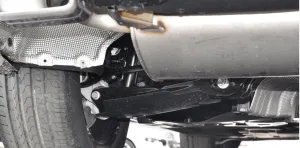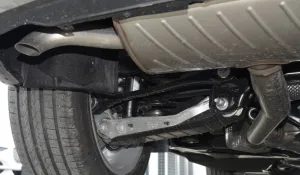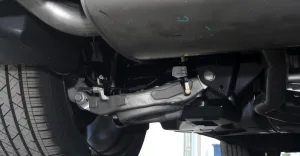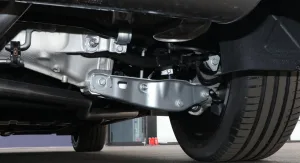When it comes to automotive suspension systems, the control arm—often referred to as the lower control arm or swing arm—is a critical component. Positioned between the wheel and the subframe or chassis, it transmits forces and torques while guiding the wheel’s vertical movement to keep it close to the ground. Paired with a shock absorber, it ensures a comfortable ride on uneven roads. However, a debate persists in the automotive world: which material is better for control arms—iron/steel or aluminum alloy? In this article, we dive into the differences, advantages, and trade-offs of each material to determine which one comes out on top.
Understanding the Role of Control Arms
Control arms are pivotal in a vehicle’s suspension system, whether used in the front or rear. Their primary functions are:
- Force Transmission: They transfer forces and torques between the wheel and the chassis or subframe.
- Wheel Guidance: They constrain the wheel’s vertical motion to maintain tire contact with the road.
- Comfort Enhancement: When paired with a shock absorber, they form a soft connection to absorb road shocks.
Control arms, especially lower ones closer to the ground, are typically made from two main materials: cast iron/steel or aluminum alloy. Each material has distinct properties that influence performance, cost, and application.
Steel/Cast Iron Control Arms: The Cost-Effective Choice
Steel or cast iron control arms dominate the market, particularly in mainstream and budget-friendly vehicles. Their widespread use stems from several key advantages:
- Cost Efficiency: Steel and cast iron are relatively inexpensive to produce, helping manufacturers keep vehicle costs down. This makes them a popular choice for mass-market models.
- Durability: These materials are robust and capable of withstanding significant stress, making them suitable for a wide range of driving conditions.
- Ease of Manufacturing: The production process for steel and cast iron components is straightforward, allowing for high-volume manufacturing.
However, steel and cast iron control arms have drawbacks:
- Weight: They are heavier than aluminum, increasing the unsprung mass (the weight of components not supported by the suspension, such as wheels and control arms). Higher unsprung mass can negatively affect ride quality and handling.
- Corrosion: Without proper coatings, steel and cast iron are prone to rust, which can reduce longevity in harsh environments.
Many vehicles, including luxury models like the BMW X3, Mercedes-Benz GLC, Lexus NX, and Cadillac XT5, use steel or cast iron lower control arms. These brands demonstrate that steel can meet comfort and handling requirements without the added cost of aluminum, especially when cost control is a priority.
Aluminum Alloy Control Arms: The Lightweight Performer
Aluminum alloy control arms are often associated with premium or performance-oriented vehicles, such as the Audi Q5L, Jaguar F-PACE, and Lincoln Nautilus. Their key characteristics include:
- Lightweight Design: Aluminum is significantly lighter than steel, reducing unsprung mass. This leads to two main benefits:
- Faster Shock Absorber Response: Lighter control arms allow the shock absorber to rebound more quickly, reducing wheel lift over bumps (e.g., speed bumps) and improving ride comfort.
- Enhanced Handling: Lower unsprung mass improves tire grip on uneven surfaces, boosting stability and cornering performance.
- Corrosion Resistance: Aluminum is naturally resistant to rust, increasing durability in wet or salty conditions.
- Performance Optimization: In vehicles like the Jaguar F-PACE, which uses a full-aluminum chassis derived from a sports car platform, aluminum control arms enhance dynamic performance.
Despite these advantages, aluminum alloy control arms come with challenges:
- Higher Cost: Aluminum is more expensive to manufacture and process, increasing vehicle production costs and repair expenses. Replacing an aluminum control arm after a collision is pricier than replacing a steel one.
- Complexity in Manufacturing: Aluminum components often require advanced techniques, such as forging (as seen in the Audi Q5L), to achieve the desired strength-to-weight ratio.
Real-World Applications: How Brands Choose Materials
To understand how manufacturers select control arm materials, let’s examine a few examples from popular models in the premium SUV segment, similar in price to the Li Auto L9, which sparked this debate:
- BMW X3, Mercedes-Benz GLC, Lexus NX, Cadillac XT5: These models use steel or cast iron lower control arms. Despite their luxury branding, these manufacturers prioritize cost control while still meeting performance and comfort standards. Steel arms are sufficient for their suspension designs and expected loads.

Audi Q5L: The Audi Q5L uses forged aluminum lower control arms, even though newer models have reduced aluminum use in other suspension components to cut costs. The forged aluminum arms maintain a lightweight design without compromising strength.

Jaguar F-PACE: As a brand committed to aluminum-intensive designs, Jaguar uses aluminum control arms to enhance the vehicle’s sporty handling, aligning with its performance-oriented platform
 .
.Lincoln Nautilus: This SUV features aluminum lower control arms with hollowed-out designs for added weight savings. The reduced unsprung mass improves handling, stability, and comfort.

Li Auto L9: The Li Auto L9 opts for steel lower control arms with a corrosion-resistant coating to enhance durability. While it uses aluminum in other components like the rear subframe and steering knuckles, the steel control arms meet the vehicle’s comfort and handling targets while keeping costs in check.

The Verdict: Which Material Wins?
The choice between steel/cast iron and aluminum alloy control arms depends on the vehicle’s purpose, target market, and cost considerations. Neither material is inherently “better”—each serves specific needs:
- Steel/Cast Iron: Ideal for cost-conscious vehicles or those where performance demands are met without lightweight materials. The use of anti-corrosion coatings, as seen in the Li Auto L9, mitigates rust concerns, and the lower cost benefits consumers by keeping vehicle prices competitive. For budget or mid-range models (e.g., vehicles priced around $20,000), steel is often paired with compromises in other features if aluminum is used elsewhere.
- Aluminum Alloy: Preferred for premium or performance vehicles where reduced unsprung mass enhances handling and comfort. However, the higher cost of aluminum translates to pricier vehicles and repairs, which may deter budget-conscious buyers.
For consumers, the decision hinges on priorities:
- If affordability and durability are key, steel or cast iron control arms are a practical choice, delivering reliable performance at a lower cost.
- If performance and lightweight design are priorities, aluminum alloy control arms offer superior handling and comfort, albeit at a premium.
The iron vs. aluminum control arm debate isn’t about one material being superior—it’s about trade-offs. Steel and cast iron provide cost-effective durability, while aluminum offers lightweight performance at a higher price. Manufacturers like BMW and Audi carefully balance these factors based on their vehicle’s design goals. As a consumer, consider your driving needs, budget, and whether the benefits of aluminum justify the cost. Have a favorite material or vehicle? Share your thoughts in the comments!



 .
.
